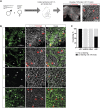Lgr5+ stem and progenitor cells reside at the apex of a heterogeneous embryonic hepatoblast pool
- PMID: 31142540
- PMCID: PMC6602348
- DOI: 10.1242/dev.174557
Lgr5+ stem and progenitor cells reside at the apex of a heterogeneous embryonic hepatoblast pool
Abstract
During mouse embryogenesis, progenitors within the liver known as hepatoblasts give rise to adult hepatocytes and cholangiocytes. Hepatoblasts, which are specified at E8.5-E9.0, have been regarded as a homogeneous progenitor population that initiate differentiation from E13.5. Recently, scRNA-seq analysis has identified sub-populations of transcriptionally distinct hepatoblasts at E11.5. Here, we show that hepatoblasts are not only transcriptionally but also functionally heterogeneous, and that a subpopulation of E9.5-E10.0 hepatoblasts exhibit a previously unidentified early commitment to cholangiocyte fate. Importantly, we also identify a subpopulation constituting 2% of E9.5-E10.0 hepatoblasts that express the adult stem cell marker Lgr5, and generate both hepatocyte and cholangiocyte progeny that persist for the lifespan of the mouse. Combining lineage tracing and scRNA-seq, we show that Lgr5 marks E9.5-E10.0 bipotent liver progenitors residing at the apex of a hepatoblast hierarchy. Furthermore, isolated Lgr5+ hepatoblasts can be clonally expanded in vitro into embryonic liver organoids, which can commit to either hepatocyte or cholangiocyte fates. Our study demonstrates functional heterogeneity within E9.5 hepatoblasts and identifies Lgr5 as a marker for a subpopulation of bipotent liver progenitors.
Keywords: Bipotent; Hepatoblast; Lgr5; Liver development; Liver stem/progenitor cells; Organoid.
© 2019. Published by The Company of Biologists Ltd.
Conflict of interest statement
Competing interestsThe authors declare no competing or financial interests.
Figures






References
-
- Amir E.-D., Davis K. L., Tadmor M. D., Simonds E. F., Levine J. H., Bendall S. C., Shenfeld D. K., Krishnaswamy S., Nolan G. P. and Pe'er D. (2013). viSNE enables visualization of high dimensional single-cell data and reveals phenotypic heterogeneity of leukemia. Nat. Biotechnol. 31, 545-552. 10.1038/nbt.2594 - DOI - PMC - PubMed
Publication types
MeSH terms
Substances
Grants and funding
LinkOut - more resources
Full Text Sources
Molecular Biology Databases
Miscellaneous

